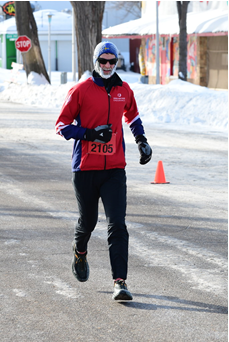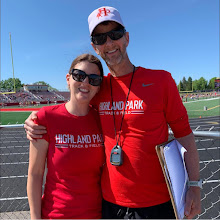An 18-week marathon program
sure seems like a long time. But then I blinked, and I was already done with 6
weeks of the training. At the start of this 80/20 program, I was a little
concerned with having 2 workouts per week, plus long runs. But, as of right
now, I’m really happy with how the program is going. I basically hit all of the
workouts in the first 6 weeks (except for one workout in week #5). There is a
lot of variety, and I don’t feel like I’m doing the same workouts over and
over. And, best of all, I’m seeing results. Despite all the shitty weather, and
running by feel due to snow and ice, I’m feeling much more fit and I’m gaining
confidence. What more do you want from a program?!
At the end of week #6
I pushed my long run from Saturday to Sunday because I was at an indoor track
meet Saturday morning. This worked well too because I had a 10-mile race
planned the following Sunday. The Monday of week #7 I was thrown my first curve
ball as I woke up not feeling well. The only thing that comes to mind is that I
ate some homemade sprouts that had been in the fridge for over a week. No big
deal, I took the day off – my first unscheduled day off this cycle – and then
bounced back with a great workout on Tuesday. I skipped my second workout of
the week – substituting in some strides instead. Mainly, I didn’t want 2 hard
workouts and a race all in one week.
I was a little
concerned about Sunday’s race because we received another 10” of snow Friday
night and into Saturday morning. Luckily it was enough time to clear the snow
and let the sun dry out the pavement. The course ended up having some slippery
spots, but not nearly as bad as it could have been. Sidenote: we are now up to
the 3rd snowiest winter in Twin Cities history. Yay us!
I’m happy to report
that the race went very well. I started this recent journey with a Thanksgiving
8K at 7:12 pace. I was able to manage 7:10 pace for 10 miles last Sunday. That’s
according to my watch. The official results had me one second under 1:11, which
is 7:06 pace. If you believe all the pace charts out there, that means my
marathon fitness level has gone from 3:30 to 3:20. I’m really pleased with that
progress. I initially set my “B” goal as 3:25, which is my BQ, and my “A” goal
as 3:20. To have race results in early April that point towards my “A” is quite
reassuring.
Honestly, I don’t
know if I’m in 3:20 shape quite yet. The pace calculator that I’m using says I’m
in about 1:36 half marathon shape. If I double that to 3:12, I only have to add
8 minutes to get to 3:20. Looking back at my race history leading up to
marathons, my results are typically an additional 12 minutes more than double
my half marathon times. That means I’m in more like 3:24 shape. In any case, I
still have 10+ weeks of training left to keep improving.
Back when I was
training a lot and racing more frequently, it seemed like my fitness never
changed. I could always predict my race times within a couple of seconds –
marathons within a minute or two. Race fitness was one of those things I took
for granted, until I didn’t have it.
This time around,
starting the process out of shape, it’s been really fun to feel myself
improving and see my race times getting faster.
WEEK #4
RECAP OF WEEK 3/5 – 3/11
Sunday – 4 miles
Monday – AM: Strength + 2.5-mile shakeout, NOON: 8.5
miles, including 6 x 4:00 @ CV
Tuesday – 6-mile foundations run
Wednesday – AM: Strength, NOON 7-mile foundations run
Thursday – AM: 7.5 miles, including 3 x (10 x :30)
Friday – AM: 5.7 miles w/ Pat, PM: 2.8-mile shakeout
Saturday – 12-mile-long run, including 3 x 2 miles @ HMP –
first 2 reps w/ Evan
Summary: 56 miles and 2 strength training
WEEK #5
RECAP OF WEEK 3/12 – 3/18
Sunday – 4 miles
Monday – AM: 8.5 miles, including 4 x (3:00 at Z3, 3:00
at ZY, 3:00 at Z1)
Tuesday – AM: 2-mile shakeout, PM: 3.2-mile foundations
run
Wednesday – AM: Strength, NOON: 7-mile foundations run
Thursday – Feeling out of sorts, skipped main workout;
PM: 3.7 miles, including 8 x 1:00 hills w/ track team
Friday – 5-mile foundations run
Saturday – 18-mile-long run w/ Scott on pack snowy trail
Summary: 55 miles and 1 strength training
WEEK #6
RECAP OF WEEK 3/19 – 3/25
Sunday – Scheduled day off
Monday – AM: Strength + 2.5-mile shakeout, NOON: 7-mile
Progression Run (12:00 @ Tempo, 6:0) @ TH, 3:00 @ CV)
Tuesday – 5-mile foundations run
Wednesday – 7-mile foundations run w/ strides
Thursday – AM: Strength + 2.5-mile shakeout, NOON: 8
miles, including 12 x (:45 w/ 1:45 jog)
Friday – 5.2 miles foundations run w/ Scott
Saturday – 4-mile recovery run
Summary: 41.2 miles of running and 1 strength training
WEEK #7
RECAP OF WEEK 3/26 – 4/1
Sunday – 11-mile Fast Finish, including last 10:00 @ Z3
Monday – day off – not feeling well (sprouts?)
Tuesday – 10-mile run, including 8 x 1K @ 10K pace w/
1:00 rest
Wednesday – 6-mile foundations run w/ PRG group
Thursday – 6.5-mile foundations run w/ Scott
Friday – 5 miles foundations run w/ 8 x :20 strides
Saturday – day off (race tomorrow + shoveled snow)
Summary: 38.5 miles of running
Quote of the day;
“Gratitude is the sign of noble souls.” – Aesop





